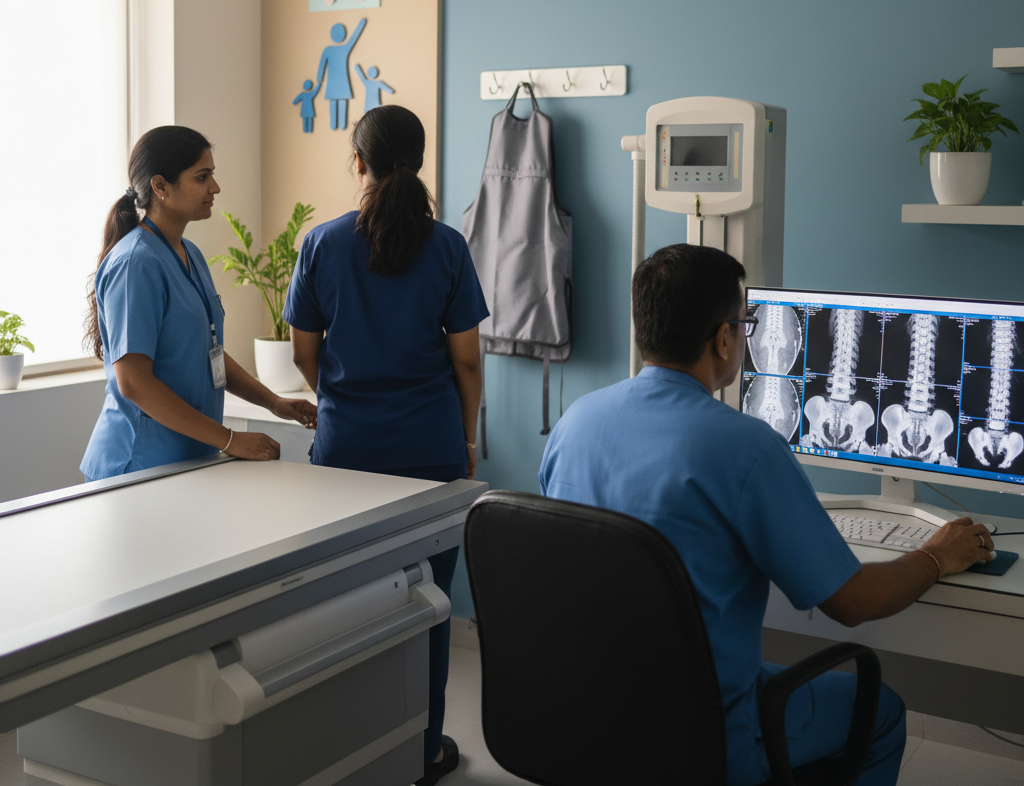X-ray for Back Pain Near Me: When to Get One and What to Expect at Sanchet Hospital, Paschim Vihar
When to get an X-ray for back pain: red flags, duration and clinical indications
Searching for “X-ray for Back Pain Near Me”? Good question. We don’t recommend routine X-rays for uncomplicated acute low back pain in the first six weeks. Current guidelines advise avoiding early imaging unless warning signs are present. (See AAFP guidance.) AAFP: Imaging for Low Back Pain
Red flags that should prompt imaging right away include:
- Severe or progressive neurological deficit (weakness, foot drop).
- Recent significant trauma (fall, accident) with persistent pain.
- Fever, unexplained weight loss, history of cancer (possible infection or tumour).
- Bladder or bowel dysfunction, saddle anaesthesia (possible cauda equina).
- Ongoing severe pain beyond six weeks despite conservative care.
If you have one of these signs, an X-ray may be the first test. It helps detect bone problems quickly. For most other patients, simple conservative care first is usually best.
What an X-ray for back pain can show — fractures, alignment issues — and limitations compared with MRI/CT
An X-ray for back pain shows bone detail. It is excellent for finding fractures, scoliosis, degenerative changes, and gross alignment problems. It can also suggest arthritis or bony tumours. The test is fast and widely available. However, X-rays have limits. They do not show soft tissues well. Problems like disc herniation, nerve impingement, or early infection are better seen on MRI or CT.
Key differences:
- X-ray: best for bones and alignment; quick and low cost.
- CT: cross-sectional bone detail; useful after trauma or complex fractures.
- MRI: best for discs, nerves, spinal cord, and infection or tumour suspicion.
For more details on what to expect from a spine X-ray, the Cleveland Clinic explains purpose and limits well. Cleveland Clinic: Spine X-Ray
When we evaluate your back pain, we choose the imaging that answers the clinical question. That way you avoid unnecessary tests and radiation.
Your X-ray visit at Sanchet Hospital: preparation, procedure, radiation safety, and pediatric/pregnancy considerations
If you search “X-ray for Back Pain Near Me” and choose our centre, here’s what to expect. We use digital, low-dose X-ray equipment. This reduces radiation while keeping image quality high. You may be asked to remove metal and change into a gown. Protective shielding covers areas not imaged. The exam is usually painless and takes about 10–15 minutes. (Cleveland Clinic notes similar timing.) Cleveland Clinic
Pregnancy and child safety:
- Tell us if you are or might be pregnant. We will adjust the plan. (Johns Hopkins guidance.) Johns Hopkins: X-rays in Pregnancy
- For children, we follow paediatric dose protocols and shielding.
- We can coordinate with our paediatrician for child-focused care. See our paediatric services: Pediatrician at Sanchet Hospital
We also provide friendly instructions to help you stay comfortable during positioning. Our radiology team discusses the risk-benefit before imaging. For more about our imaging approach and low-dose digital systems see our imaging page. Sanchet Hospital Imaging
For pregnancy-related consultation we can also involve our gynaecology team: Gynaecology at Sanchet Hospital
X-Ray Timings and Cost at Sanchet Hospital
Looking for “X-ray for Back Pain Near Me” in Paschim Vihar? We make it simple. You can walk in during our OPD hours, Monday to Saturday, 10:00 AM to 8:00 PM. We do not require appointments for routine X-rays. If you prefer, call reception at 011-43106000 to confirm availability. Our hospital address is 436 Bhera Enclave, Paschim Vihar, New Delhi. Google Maps: Location.
Typical logistics and costs:
- X-ray (digital) price — INR 500 (our standard listed rate).
- Walk-ins accepted during OPD hours; emergency imaging handled as needed.
- Parking is available in front of the hospital.
- Reports are available quickly and downloadable through Lal Path Labs portal when applicable.
Turnaround time is prompt. Many X-ray reports are available the same day. If urgent, tell us on arrival. We can fast-track reporting and arrange same-day orthopaedic or surgical consultation. We accept select insurance plans including HDFC Ergo and Aditya Birla for cashless claims where applicable.
After the Back Pain X-ray: interpreting results, treatment pathways, referrals, physiotherapy and prevention tips
After your X-ray for back pain, we review the images with you and explain findings in plain language. If the X-ray shows bone injury, fracture, or significant alignment change, we usually refer you to orthopaedics or our surgical consultant. We may recommend:
- Orthopaedic or spine specialist referral for fractures or instability.
- MRI/CT when soft tissue, disc, or nerve issues are suspected.
- Physiotherapy for mechanical back pain, guided exercises, and pain control.
- Pain management or follow-up imaging if symptoms persist.
Short-term management tips to reduce recurrence:
- Stay active within pain limits and avoid prolonged bed rest.
- Start gentle core and back-strengthening exercises under guidance.
- Maintain a healthy weight and ergonomics at work.
- Use heat therapy, posture correction, and graded return to activity.
If you need a follow-up or specialist appointment, we’ll help arrange it. You can also request a virtual consultation by calling 011-43106000. For children and mothers, we coordinate with paediatrics and gynaecology as needed to ensure safe, integrated care.
References:
- AAFP — Imaging for Low Back Pain
- Cleveland Clinic — Spine X-Ray
- Johns Hopkins — X-rays of the Spine, Neck or Back
- Sanchet Hospital — Imaging and safety
Questions or ready to come in? Call us at 011-43106000. We’re here Monday to Saturday, 10:00 AM to 8:00 PM.


